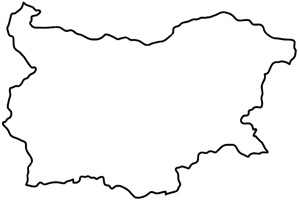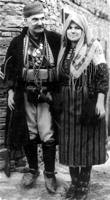
|
The Society of Folk Dance Historians (SFDH)
Choreogeography:
[
Home |
About |
Encyclopedia | CLICK AN IMAGE TO ENLARGE |

|
 Tiny Bulgaria has always been of major interest to folk dancers. From this remote corner of the Balkans comes some of the most fascinating, challenging, and enticing dances and music anywhere. Many dance ethnologists have made Bulgaria the focus of their professional study, bringing the folk dance community some of its favorite dances for decades.
Tiny Bulgaria has always been of major interest to folk dancers. From this remote corner of the Balkans comes some of the most fascinating, challenging, and enticing dances and music anywhere. Many dance ethnologists have made Bulgaria the focus of their professional study, bringing the folk dance community some of its favorite dances for decades.
What of Bulgaria? What is it about the place that creates such folk art? Many view it as a mystical place from which come exhilarating clarinet and accordion music, complex musical rhythms, and impossibly fast footwork. Its women's chorus of traditional vocal music excited the Los Angeles "enlightened" art community a few years back.
 In reality, Bulgaria is beautiful, poor, and backward, still suffering from lack of development and a poor economic prospect. However, the people are just like everywhere else, coping as best they can with the realities of their lives and, thankfully, still cherishing and practicing their folk arts.
In reality, Bulgaria is beautiful, poor, and backward, still suffering from lack of development and a poor economic prospect. However, the people are just like everywhere else, coping as best they can with the realities of their lives and, thankfully, still cherishing and practicing their folk arts.
Researchers report that "theatrical" elements have drastically affected the folk dance and many villagers now think of the dance as performance, rather than social activity; so much for authenticity. Maybe that's progress. It remains for us to examine the music and dance of various regions of the country and the identifiable differences between them, presuming that at least some of the original characteristics have survived intact. With a little knowledge, one can identify with remarkable accuracy, the locale of many of the Bulgarian dances we love so dearly.
It is a country of picturesque mountain ranges, fertile plateaus, well drained by several river systems and a resort-oriented Black Sea coast.
Geographical features effectively divide the country into identifiable regions, each with its own folk character, which we must of necessity paint with a broad brush, briefly stereotyping each area to help identify dances' origins and understand why they take the form they do.
Everyone knows that, with rare exceptions, the line or circle dance is the predominant dance form throughout the country. One must recall that Bulgaria was probably the country most affected by the presence of the Turkish Empire; indeed, it was at the very heart of it for 500 years, from a hundred years before Columbus' voyage until World War I. The Ottoman Empire fiercely opposed any influence from the west, including the Renaissance, which introduced the concept of couples dancing together, unthinkable to those upholding the ancient morals of the Muslim world.
REGIONS
The Balkan Range: Bulgaria is divided north from south by this branch of the Austrian Alps that gives the Balkan Peninsula its name. The range has been a refuge for freedom fighters for centuries, even up through World War II, and maintains a certain militant character in many of its dances. Men dance with swords and bound high in the air in leaps typical of mountaineers whose livelihood develops powerful legs and a vertical view of the world.
The Danube Plain: Sloping gently north from the Balkan Mountains to the Danube River, the plain ends in 600-foot cliffs which drop abruptly to the river; the Romanian border on the north side slopes gently up from the river, very much like the Columbia River between Oregon and Washington. Ethnologists view the Danube Basin on both sides of the river as being a common folk culture, a theory hotly denied by both. However, many dances appear to have suspiciously similar figures and rhythms.
Northwest: Extending like a horn to the northwest into a confluence of cultures from Banat Serbia, Hungary, and the Vlachs (dislocated Bulgarians from Romania), this unnamed region possesses one of the most rich and varied dance cultures of Bulgaria. Vlach dances are very prominent in the recreational folk dance repertoire (Stara Vlajna, Raca, and Vlaško, among others).
Dobrudža: To the east, next to the Black Sea, Dobrudža is a poor region with swampy lands and poor soils, relying much on Black Sea tourist trade and a pastoral agriculture for its economy. Some of the most interesting and beloved dances of all come from here, heavy and powerful with large, expressive arm and leg gestures and names such as Rŭka, Tropanka, and Zborinka.
Sredna Gora: Little known to those who have not visited there, this small mountain range (Central Range) lies just south and parallel to the Balkan Range. Between the two, near the geographical center of the country, is the fragrant Valley of Roses, where millions of red, white, and pink roses are grown to produce one of Bulgaria's most famous exports: Aattar of roses, a major ingredient of most of the world's perfumes.
Thrace: One of the most ancient names in the Balkans, Thrace is ethnologically divided into east and west regions and extends into northern Greece. Lying south of the Balkan Range in a high, arid plateau, it requires irrigation for its bountiful crops that have nourished the people since the ancient Greeks. Thracian music has an almost unmistakable style, characterized by long-held, plaintive notes, played as though the musician is reluctant to leave each one. Though many of the dances are quick, most here are characterized as slow, soft, and earthy – danced in a crouched position. The Râčenica, Bulgaria's national dance, takes a unique and beautiful form here, danced with the arms outstretched in beautiful gestures, men slapping the thighs in syncopated rhythms as partners dance face to face (without touching, of course).
The Rhodope Mountains: To the southwest, three small mountain ranges, Rhodope, Pirin and Rila, comprise one of Bulgaria's most lovely areas. Deep gorges, high waterfalls, icy rivers, and the historic Rila Monastery make this a tourist attraction. Here is heard the mellow tones of the Rhodope gajda [bagpipe], a much larger instrument than those found elsewhere.
Šop: The westernmost region borders Serbia and Macedonia and possesses an extremely rich dance culture. Here, the dance reaches perhaps its fastest tempo. Brilliant, flashy legwork guarantees a good audience response, ensuring its popularity in dance ensembles and recreational dance repertoires.
Pirin: In the southwest, the mixed rhythms of neighboring Macedonia are very evident; Sandansko Horo, with probably the most complex rhythm in the folk dance repertoire at 22/16, comes from the town of Sandansko in this area. Pirin's folk dance company is world famous.
NATIONAL DANCES
Though most regions possess dances unique to them, several pan-Bulgarian dances are found throughout the country, with wonderful local variations. Two of the best known are: Râčenica, the national dance, appears throughout Bulgaria, colored everywhere by local aesthetics and tradition. Its 7/16 rhythm is danced with heavy, expressive, full-body pantomime in Dobrudža, quick and cat-like legwork in Šop, an almost sensuous quality in Thrace. It is one of the unifying elements of Bulgarian folklore. Interestingly, in its flirtatious couple form, it is one of the most sensuous of dances, the boy and girl teasing each other with a handkerchief in a display of male virtuosity and feminine graceful strength.
Pravo Horo is colored by each region having its own style of movement. "Pravo" means "to the right" and the dance does just that, in a classic 6-count, side-close-side-hold-step-hold figure with countless variations and styles.
Through centuries of Turkish rule and decades of Russian influence, the Bulgarians have successfully preserved their own unique folklore. It has attracted the attention of countless folk dancers drawn by the compelling, haunting strains of Bulgarian folk music and the exhilarating movements of its dance.
DOCUMENTS
- Bulgaria, a country.
- Richard Duree, an article.
Used with permission of the author.
This page © 2018 by Ron Houston.
Please do not copy any part of this page without including this copyright notice.
Please do not copy small portions out of context.
Please do not copy large portions without permission from Ron Houston.